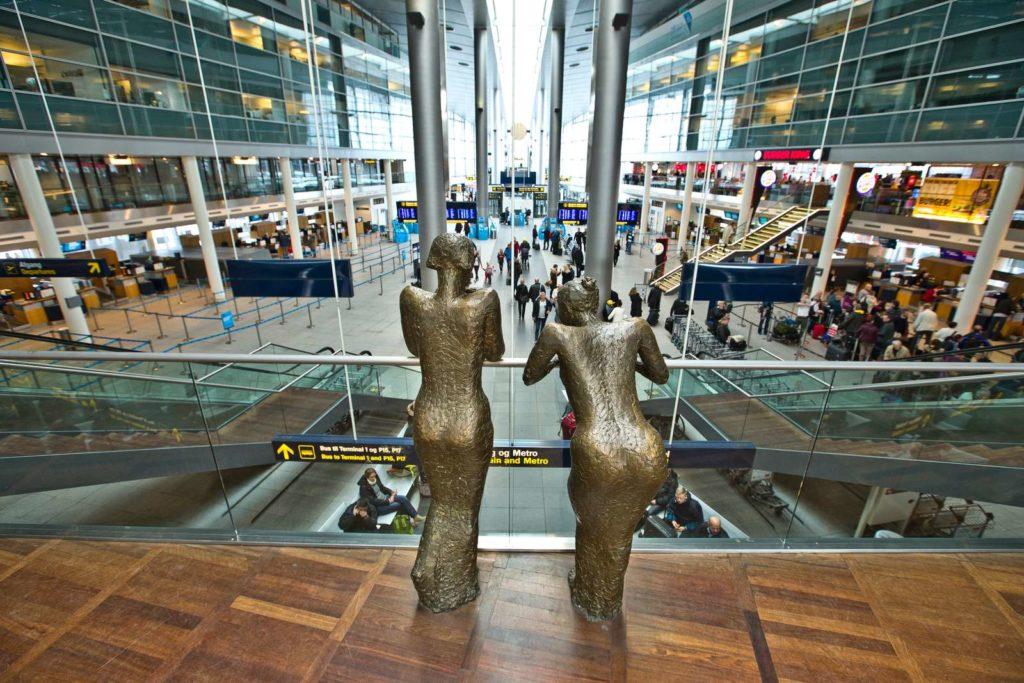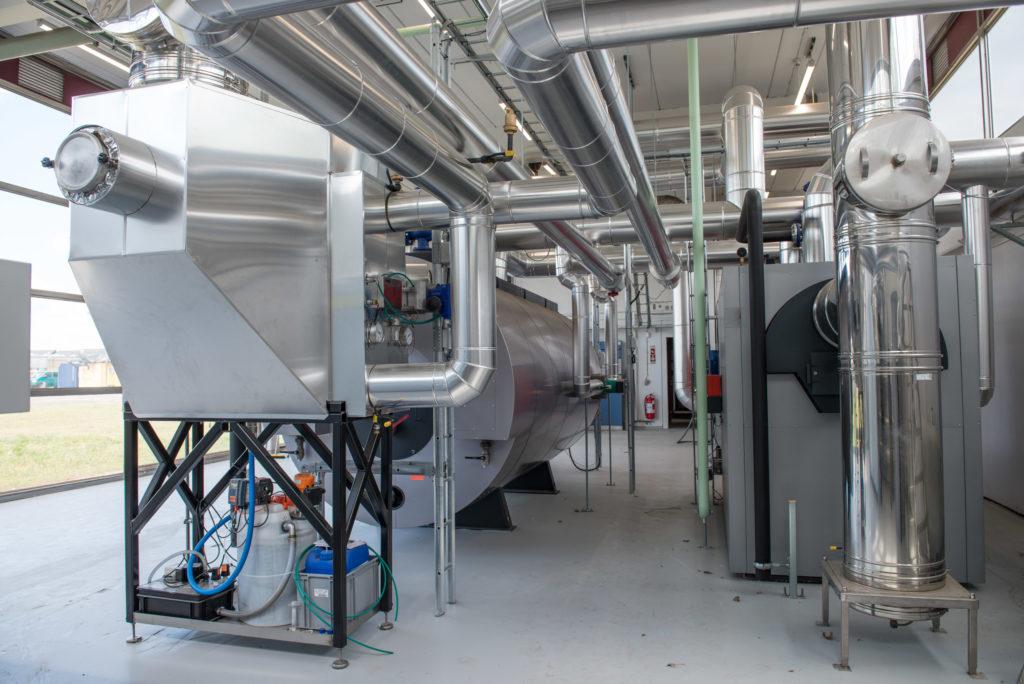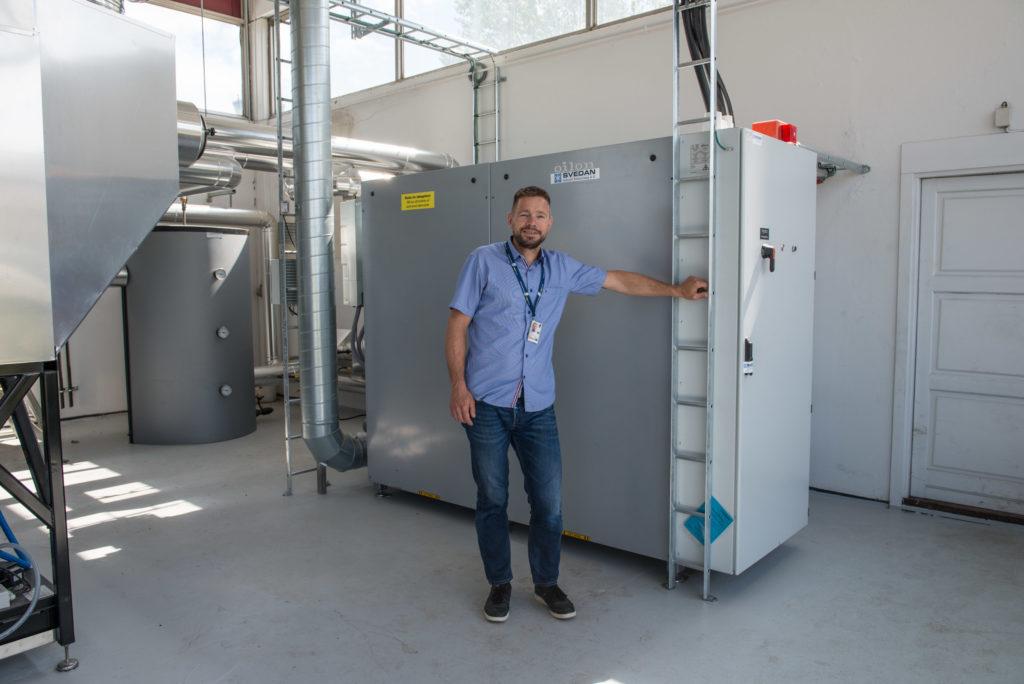Industrial heat pump improves the efficiency of a gas boiler at Copenhagen Airport
Renovation of old gas boilers expanded into a project to carefully utilise the energy of exhaust gases with an industrial heat pump. The result is, that efficiency of the gas combustion is more than one hundred per cent.
In the western Maglebylille part of Copenhagen Airport (more neatly known as CPH) there is an internal heating network. At the beginning of 2018 a decision was made to replace the old and low efficiency gas boilers that dated from the 1960s. Now the system consists of one three megawatt (3 MW) and one 2 MW natural gas boilers together with one 600-kilowatt (kW) industrial heat pump.

Flue gases are condensed with a heat pump
“When we started renovating the heating system, we wanted to look at the entirety in a new way,” says Klaus Borge, project manager at Copenhagen Airport. “The energy consultant participating in the design suggested recovery of the exhaust gas temperature with a heat pump, so we can improve the efficiency of the boiler considerably. At the same time we moved the focus of energy usage from gas to renewable electricity, which is our objective.”
According to Borge many of the facilities in the area are relatively old and the temperature of returning water from the heating network is quite high. This is because in the old days they tried to build as inexpensively as possible and the heat exchangers are small.
The temperature of supply water in the winter is 85–90 degrees centigrade (°C) and the return about 60°C. In the summer the supply is 70°C and the return 50–55°C. With such warm return it would not be possible to cool the flue gas very much and the energy in the flue gas would remain mostly wasted. With a heat pump it is possible to cool the gas to a lower temperature while the pump operates at excellent efficiency.
“The temperature of flue gas from the boiler is about 150°C,” continues Borge. “It moves through the condenser, where the temperature is lowered to some 30–35°C with the heat pump. Thanks to the low temperature the humidity of the gas is condensed into water, which adds to the amount of recovered energy and improves the efficiency of the system considerably.”

High temperature and great control
“At the beginning of the project we discussed a heat pump from another manufacturer but there was no pump the right size in their selection,” says Borge. “Then we discussed with Søren Gram, director of Svedan Industri Køleanlæg A/S, retailer of Oilon. Søren presented us with the heat pumps in the Oilon ChillHeat P 300 series, that had the perfect specifications for us.”
“The Oilon heat pump can produce a very high temperature that is easily high enough for the water supply in district heating. Thanks to its four compressors and inverter control the pump can be controlled very well at high efficiency with partial loads and its environment friendly HFO refrigerant is also approved in Denmark. Under the design conditions of this project, the electricity consumption of the pump is 155 kW and COP 4.0.”
“Our experience of the quality of the Oilon heat pump and the operation of the factory as a whole is excellent. At the installation and commissioning stage we got competent and high quality support from the factory so we got the system in operation with just minor problems. Likewise the service by Svedan Industry has been strong and good.”
Heat pump utilises the heat in flue gas
The airport heating centre now has two boilers, one 3 MW natural gas boiler and one 2 MW boiler. The 3 MW boiler is connected to a condenser that cools down the flue gas. The second boiler is in reserve and for the coldest weather. It will start if the temperature has been below -10°C for a week. The spare boiler blows the hot flue gases into the sky.
At present worldwide, heat pumps are rarely used for the recovery of heat from flue gases.
The dew point of flue gas from a natural gas boiler is about 55°C. By condensing the flue gas it is possible to produce about 10% more power at its best. Condensed water is formed at up to 180 litres per hour. Water condensing also absorbs impurities from the flue gas thus cleaning the flue gas. Neutralized condensate is discharged into the sewer.
The heating plant produces about 10,000 megawatt hours (MWh) heat yearly, which equals to the consumption of about 500 private houses. To produce the heat about one million cubic meters of natural gas and 400 MWh electric power is used. The savings with the heat pump is estimated to be about 1,000 MWh per year.

Electricity and energy efficiency instead of natural gas
“There is high pressure to reduce our greenhouse gas emissions and show that CPH will be an emission free airport in 2030,” says Klaus Borge. “The Oilon heat pump with its 600 kW heating capacity has some excess power for cooling our flue gases. Our intention, however, is to furnish the system with glycol circulation heat exchangers outside, that recover energy from the outside air from spring to autumn and then we can close the gas boiler for the summer period.”
“On the roof of the house next to us there are now 125 kW solar panels and 250 kW more are being installed right now. We have even considered acquiring batteries so the heat pump could even run on solar energy at night.”
According to Borge the price of electricity for CPH is roughly one Danish crown per kilowatt hour (1 DKK/kWh). The price of natural gas is about 5 DKK/m3 i.e. 0.50 DKK/kWh. The heat pump however produces four times more heat compared to its electricity consumption so it costs only half the price to heat with the pump compared to gas. Denmark has some gas fields in the North Sea but the present government wants to close them. On the other hand more and more biogas is being produced in Denmark.
“CPH has been able to reduce its energy consumption considerably year after year, but there is still a lot to do,” says Borge. “It is clear that we will move to using more renewable electricity instead of gas. All excess electricity is currently used for charging electric cars and it takes time to reinforce the grid. The amount of solar energy will increase strongly.”
“We are investing heavily in saving energy and heat pumps have an important role in this. A heat pump will pay itself back in four years so it is also a very profitable investment.”

